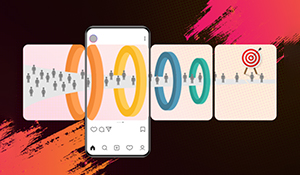While browsing social media, the consumer’s mind is interrupted by hundreds of daily posts, making it critical to know how to capture their attention and make them scroll through our posts the way we want them to.
This brings us to the significance of content and its types. Carousels have recently become one of the most popular and successful types of content for META after videos.
There are various ways to write your carousels in order to effectively convey the information and have the audience read it all, but the AIDA Model is one of the most known and effective techniques.
What is the AIDA Model?
It’s one of the oldest sales approach methodologies, yet still one of the most successful ones today. The AIDA model goes through the different stages a person goes through while buying a product or a service and covers the main points a marketer should focus on in each stage.
Now, what does AIDA stand For?
AIDA model works for ad copy, website copy, and most importantly, social media copy. Learning how to use it to increase social media effectiveness for business is so important.
AIDA in Carousels
Carousels are an excellent approach to effectively provide varying information to readers since you can fit them into 10 different cards, which is enough to achieve your goal, such as, for example, generating leads. It’s important to get the user to your 3rd card at least, which increases the chances of retaining them.
In fact, the more the users swipe through cards in your carousels, the more the algorithm will push your post and show it in the explore page, resulting in increased engagement and results. Thus, adopting the AIDA model in carousels can significantly help in getting the audience to swipe all the way to the end.
Even though you are only allowed 10 cards in your carousel, you must consider showing only 8, in order to peak the audience’s curiosity and persuade them to desire your products/services. While the first card is meant to get their attention, the last card is supposed to inform them of the type of action they should take.
Here is how to distribute your ideas and content along your carousel using AIDA.
Attention: In the first image, use strong headlines to grab the user’s attention and make him/her stop scrolling. Put yourself in his/her shoes, and think why should they care for this post and read it? What is in this post for them?
Based on the answers, craft a strong headline, but also work on the visuals in this slide, as they act as a hook as well, not only the headline.
Interest: Provide the audience with interesting information in each slide, and make sure you give this information in bite-sized pieces to make them scroll to find out more.
As mentioned, you have to get the user to go beyond the third image, so avoid giving a lot of information in your second image, and don’t give them the juicy value there. Instead, break it up into more images, and arouse their curiosity for the answers or the most important information, which you will state in slides 8-9.
Desire: You have now reached the 8th image in your carousel, and it’s where you should provide the most valuable information, like answers, tactics, steps, or checklists.
Action: tell them what to do. Do you want them to engage? To share this post or save it? To go to the link in bio or to buy?
As a recap, sketch your ideas into an 8 frame story beats after coming up with an attractive headline and put one idea per frame (card). Then build their interest more and more until they reach the end where you include the actionable details and information they scrolled for. Most importantly, make your CTA in the last slide specific and clear.
by Ahmad Shaghlil
Explore these Instagram trends and strategies, but don't forget to stay up-to-date with the broader landscape of social media marketing by reading our comprehensive guide on SOCIAL MEDIA MARKETING TRENDS TO WATCH OUT FOR IN 2024



